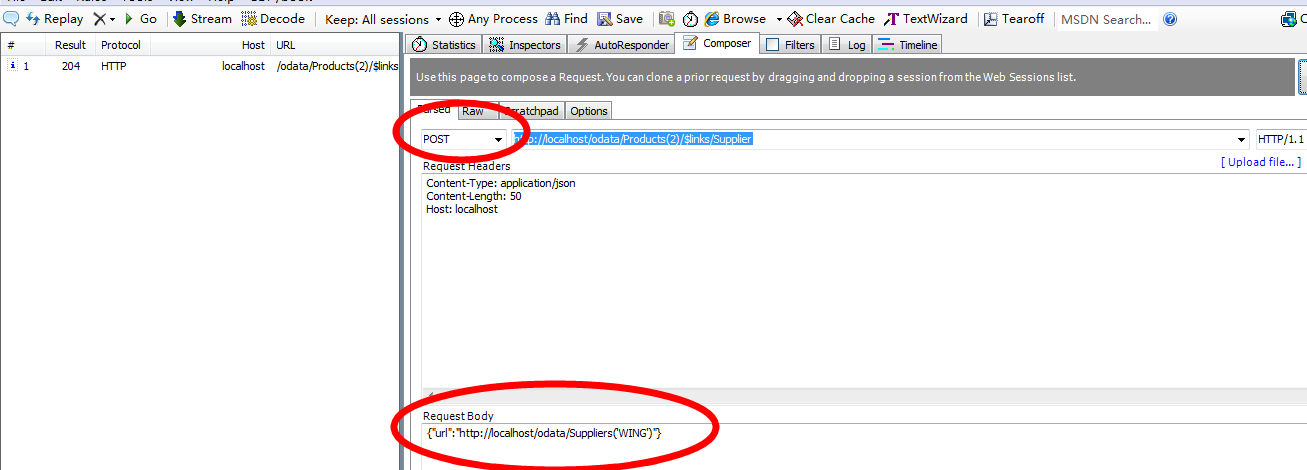前言
阅读本文之前,您也可以到Asp.Net Web API 2 系列导航进行查看 http://www.cnblogs.com/aehyok/p/3446289.html。
本文的示例代码的下载地址为http://pan.baidu.com/s/1o6lqXN8
大多数的数据集定义实体间的关系:客户有订单、书籍有作者、产品有供应商。客户端可以使用OData操作实体间的关系。给定一个产品,你可以找到该产品的供应商。您也可以创建或者删除关系。例如,您也可以为一个产品设置一个供应商。
本教程将会展示在Asp.Net Web API中支持这些操作。本文的教程是建立在上一节的教程之上http://www.cnblogs.com/aehyok/p/3545824.html。
Add a Supplier Entity添加一个供应商实体类
首先我们需要来添加一个Supplier的实体类
namespace OData.Models
{
public class Supplier
{
[Key]
public string Key { get; set; }
public string Name { get; set; }
}
}
这个类使用了一个字符串类型的实体键。在实践中,这可能比使用整形键不太常见的。但它是值得的看到OData如何处理除了整数以外的其他键类型。
接下来,我们将通过在Product类上添加一个Supplier的属性来建立一个关系。
public class Product
{
public int ID { get; set; }
public string Name { get; set; }
public decimal Price { get; set; }
public string Category { get; set; }
// New code
[ForeignKey("Supplier")]
public string SupplierId { get; set; }
public virtual Supplier Supplier { get; set; }
}
添加一个新的DbSet到ProductServiceContext类,从而使实体框架将包括Supplier在数据库表中。
public class ProductServiceContext : DbContext
{
public ProductServiceContext() : base("name=ProductServiceContext")
{
}
public DbSet<Product> Products { get; set; }
///New Code
public DbSet<Supplier> Suppliers { get; set; }
}
在WebApiConfig.cs,添加一个“Suppliers”实体的EDM模型:
ODataConventionModelBuilder builder = new ODataConventionModelBuilder();
builder.EntitySet<Product>("Products");
// New code:
builder.EntitySet<Supplier>("Suppliers");
Navigation Properties导航属性
为了得到一个产品的供应商,客户端发送了一个Get请求:
GET /Products(1)/Supplier
在Product类型上有一个Supplier的导航属性。在这个实例中,Supplier是一个单一的项。但是一个导航属性也能返回一个集合(一对多或者多对多的 关系)。
为了支持这个请求,在ProductsController上添加如下方法:
// GET /Products(1)/Supplier
public Supplier GetSupplier([FromODataUri] int key)
{
Product product = db.Products.FirstOrDefault(p => p.ID == key);
if (product == null)
{
throw new HttpResponseException(HttpStatusCode.NotFound);
}
return product.Supplier;
}
key这个参数就是这个Product的键。这个方法返回关联的实体——在这个实例中,就是一个Supplier对象。方法的名称和参数的名称都是非常重要的。总之,如果导航属性被命名为一个“X”,你需要添加一个被命名为“GetX”的方法。这个方法必须采用一个命名为“key”的参数,用来匹配父类数据类型的key。
它也是很重要的在键参数上拥有【FromOdataUri】的属性。当它从请求的URL中解析键时,这个属性将会告诉Web API去使用Odata语法规则。
Creating and Deleting Links
OData支持创建和删除两个实体之间的关系。在OData术语中,这个关系就是一个“link”。每个link有一个携带entity/$links/entity的Url。例如,由产品到供应商的链接看起来像这样:
/Products(1)/$links/Supplier
为了创建一个新的链接,这个客户端发送了一个post请求到这个链接URI。请求的消息体就是目标实体的URI。例如,假设有一个供应商的键为“CTSO”。为了创建一个链接由“Product(1)”到”Supplier('CTSO')“,客户端发送一个请求如下:
POST http://localhost/odata/Products(1)/$links/Supplier Content-Type: application/json Content-Length: 50
{"url":"http://localhost/odata/Suppliers('CTSO')"}
对于删除一个链接,客户端发送了一个DELETE 请求到链接URI。
Creating Links
为启用一个客户端去创建产品-供应商的链接,需要在ProductsController类中添加如下的代码:
[AcceptVerbs("POST", "PUT")]
public async Task<IHttpActionResult> CreateLink([FromODataUri] int key, string navigationProperty, [FromBody] Uri link)
{
if (!ModelState.IsValid)
{
return BadRequest(ModelState);
}
Product product = await db.Products.FindAsync(key);
if (product == null)
{
return NotFound();
}
switch (navigationProperty)
{
case "Supplier":
string supplierKey = GetKeyFromLinkUri<string>(link);
Supplier supplier = await db.Suppliers.FindAsync(supplierKey);
if (supplier == null)
{
return NotFound();
}
product.Supplier = supplier;
await db.SaveChangesAsync();
return StatusCode(HttpStatusCode.NoContent);
default:
return NotFound();
}
}
这个方法有三个参数:
第一个key:就是引导到父类实体的键
第二个navigationProperty: 导航属性的名称。例如,最合适的导航属性Supplier。
第三个link:被链接实体的OData的URI。这个值是从消息体中获得。例如,这个链接URI可能是”http://localhost/odata/Suppliers('CTSO')“,也就是供应商中有ID="CTSO"。
这个方法用这个链接去查找Supplier。如果匹配的供应商被发现,这个方法将会设置Product实体类的Supplier的属性,并且保存结果到数据库。
其中最难的部分是解析链接URI。从根本上来说,你需要模拟发送一个get请求到那个URI。接下来的辅助方法将会展示如何处理它。这个方法调用Web API路由过程,返回一个OData实体,展现被转换的OData路径。对于一个链接URI,这个片段数中应该有一个实体键。
// Helper method to extract the key from an OData link URI.
private TKey GetKeyFromLinkUri<TKey>(Uri link)
{
TKey key = default(TKey);
// Get the route that was used for this request.
IHttpRoute route = Request.GetRouteData().Route;
// Create an equivalent self-hosted route.
IHttpRoute newRoute = new HttpRoute(route.RouteTemplate,
new HttpRouteValueDictionary(route.Defaults),
new HttpRouteValueDictionary(route.Constraints),
new HttpRouteValueDictionary(route.DataTokens), route.Handler);
// Create a fake GET request for the link URI.
var tmpRequest = new HttpRequestMessage(HttpMethod.Get, link);
// Send this request through the routing process.
var routeData = newRoute.GetRouteData(
Request.GetConfiguration().VirtualPathRoot, tmpRequest);
// If the GET request matches the route, use the path segments to find the key.
if (routeData != null)
{
ODataPath path = tmpRequest.GetODataPath();
var segment = path.Segments.OfType<KeyValuePathSegment>().FirstOrDefault();
if (segment != null)
{
// Convert the segment into the key type.
key = (TKey)ODataUriUtils.ConvertFromUriLiteral(
segment.Value, ODataVersion.V3);
}
}
return key;
}
Deleting Links
对于删除一个链接,在ProductsController类中添加如下代码:
public async Task<IHttpActionResult> DeleteLink([FromODataUri] int key, string navigationProperty)
{
Product product = await db.Products.FindAsync(key);
if (product == null)
{
return NotFound();
}
switch (navigationProperty)
{
case "Supplier":
product.Supplier = null;
await db.SaveChangesAsync();
return StatusCode(HttpStatusCode.NoContent);
default:
return NotFound();
}
}
在这个例子中,这个导航属性是一个简单的Supplier实体。如果导航属性是一个集合,对于删除一个链接的URI必须在被关联的实体中有一个键。例如:
DELETE /odata/Customers(1)/$links/Orders(1)
这里展示的则是1对多的关系中,删除其中的一个的例子。
这个请求就是从客户1中移除订单为1的。这个DeleteLink方法将会有如下签名:
void DeleteLink([FromODataUri] int key, string relatedKey, string navigationProperty);
简单测试结果
1、http://localhost:3629/Odata/Products(1)/Supplier

2、
将ID=2的Supplier修改为WING
请求Header
POST http://localhost/odata/Products(2)/$links/Supplier Content-Type: application/json Content-Length: 50
请求Body
{"url":"http://localhost/odata/Suppliers('WING')"}

现在再次查看http://localhost/Odata/Products

3、DELETE http://localhost/odata/Products(2)/$links/Supplier那么这样就可以将上面的SupplierId=WING修改为null
然后再次执行http://localhost/Odata/Products查看

总结
本文所参考链接为http://www.asp.net/web-api/overview/odata-support-in-aspnet-web-api/working-with-entity-relations
本文示例代码下载地址为http://pan.baidu.com/s/1o6lqXN8
